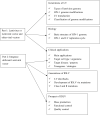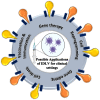Integrase deficient lentiviral vector: prospects for safe clinical applications
- PMID: 35979475
- PMCID: PMC9377332
- DOI: 10.7717/peerj.13704
Integrase deficient lentiviral vector: prospects for safe clinical applications
Abstract
HIV-1 derived lentiviral vector is an efficient transporter for delivering desired genetic materials into the targeted cells among many viral vectors. Genetic material transduced by lentiviral vector is integrated into the cell genome to introduce new functions, repair defective cell metabolism, and stimulate certain cell functions. Various measures have been administered in different generations of lentiviral vector systems to reduce the vector's replicating capabilities. Despite numerous demonstrations of an excellent safety profile of integrative lentiviral vectors, the precautionary approach has prompted the development of integrase-deficient versions of these vectors. The generation of integrase-deficient lentiviral vectors by abrogating integrase activity in lentiviral vector systems reduces the rate of transgenes integration into host genomes. With this feature, the integrase-deficient lentiviral vector is advantageous for therapeutic implementation and widens its clinical applications. This short review delineates the biology of HIV-1-erived lentiviral vector, generation of integrase-deficient lentiviral vector, recent studies involving integrase-deficient lentiviral vectors, limitations, and prospects for neoteric clinical use.
Keywords: Cell Reprogramming; Cell death; Gene therapy; Immunization; Integrase-deficient lentiviral vector.
©2022 Yew et al.
Conflict of interest statement
The authors declare there are no competing interests.
Figures





Similar articles
-
Transient Expression of Green Fluorescent Protein in Integrase-Defective Lentiviral Vector-Transduced 293T Cell Line.Methods Mol Biol. 2016;1448:159-73. doi: 10.1007/978-1-4939-3753-0_12. Methods Mol Biol. 2016. PMID: 27317180
-
Lentiviral vectors with a defective integrase allow efficient and sustained transgene expression in vitro and in vivo.Proc Natl Acad Sci U S A. 2006 Nov 21;103(47):17684-9. doi: 10.1073/pnas.0606197103. Epub 2006 Nov 9. Proc Natl Acad Sci U S A. 2006. PMID: 17095605 Free PMC article.
-
Comparative genomic integration profiling of Sleeping Beauty transposons mobilized with high efficacy from integrase-defective lentiviral vectors in primary human cells.Mol Ther. 2011 Aug;19(8):1499-510. doi: 10.1038/mt.2011.47. Epub 2011 Apr 5. Mol Ther. 2011. PMID: 21468003 Free PMC article.
-
The Old and the New: Prospects for Non-Integrating Lentiviral Vector Technology.Viruses. 2020 Sep 29;12(10):1103. doi: 10.3390/v12101103. Viruses. 2020. PMID: 33003492 Free PMC article. Review.
-
Lentiviral Vectors for Delivery of Gene-Editing Systems Based on CRISPR/Cas: Current State and Perspectives.Viruses. 2021 Jul 1;13(7):1288. doi: 10.3390/v13071288. Viruses. 2021. PMID: 34372494 Free PMC article. Review.
Cited by
-
Engineering strategies to safely drive CAR T-cells into the future.Front Immunol. 2024 Jun 19;15:1411393. doi: 10.3389/fimmu.2024.1411393. eCollection 2024. Front Immunol. 2024. PMID: 38962002 Free PMC article. Review.
-
Emerging trends in virus and virus-like particle gene therapy delivery to the brain.Mol Ther Nucleic Acids. 2024 Jul 19;35(3):102280. doi: 10.1016/j.omtn.2024.102280. eCollection 2024 Sep 10. Mol Ther Nucleic Acids. 2024. PMID: 39206077 Free PMC article. Review.
-
The Use of Natural Methods to Control Foodborne Biofilms.Pathogens. 2022 Dec 27;12(1):45. doi: 10.3390/pathogens12010045. Pathogens. 2022. PMID: 36678393 Free PMC article. Review.
-
Overexpression of salusin‑α upregulates AdipoR2 and activates the PPARα/ApoA5/SREBP‑1c pathway to inhibit lipid synthesis in HepG2 cells.Int J Mol Med. 2023 May;51(5):41. doi: 10.3892/ijmm.2023.5244. Epub 2023 Apr 7. Int J Mol Med. 2023. PMID: 37026514 Free PMC article.
-
Generation of a Beta-Cell Transplant Animal Model of Diabetes Using CRISPR Technology.Adv Exp Med Biol. 2023;1409:145-159. doi: 10.1007/5584_2022_746. Adv Exp Med Biol. 2023. PMID: 36289162
References
-
- Almarza D, Bussadori G, Navarro M, Mavilio F, Larcher F, Murillas R. Risk assessment in skin gene therapy: viral-cellular fusion transcripts generated by proviral transcriptional read-through in keratinocytes transduced with self-inactivating lentiviral vectors. Gene Therapy. 2011;18:674–681. doi: 10.1038/GT.2011.12. - DOI - PubMed
-
- Annoni A, Battaglia M, Follenzi A, Lombardo A, Sergi-Sergi L, Naldini L, Roncarolo M-G. The immune response to lentiviral-delivered transgene is modulated in vivo by transgene-expressing antigen-presenting cells but not by CD4+CD25+ regulatory T cells. Blood. 2007;110:1788–1796. doi: 10.1182/blood-2006-11-059873. - DOI - PubMed
-
- Ausubel LJ, Laderman KA, Shakeley M, Sharma A, Couture S, Lopez P, Knoblauch C, Anderson J, Derecho I, McMahon R, Hsu D, Couture L. 312. Large scale lentiviral vector production in a GMP facilty. Molecular Therapy. 2007;15(Suppl 1):S118. doi: 10.1016/s1525-0016(16)44518-1. - DOI
Further reading
-
- . European Medicines AgencyGuideline on development and manufacture of lentiviral vectors. 2005
-
- Chen SH, Sun JM, Chen BM, Lin SC, Chang HF, Collins S, Chang D, Wu SF, Lu YC, Wang W, Chen TC, Kasahara N, Wang HE, Tai CK. Efficient prodrug activator gene therapy by retroviral replicating vectors prolongs survival in an immune-competent intracerebral glioma model. International Journal of Molecular Sciences. 2020;21(4):1433. doi: 10.3390/ijms21041433. - DOI - PMC - PubMed
Publication types
MeSH terms
Substances
LinkOut - more resources
Full Text Sources

